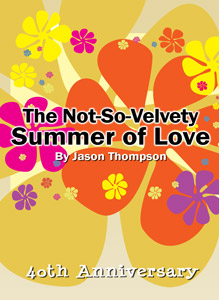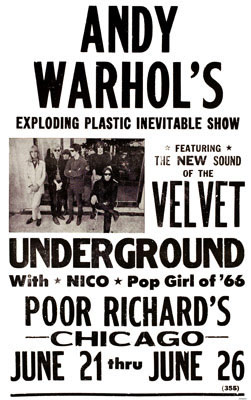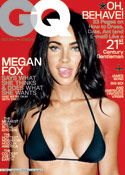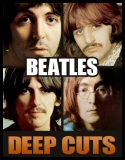
For all intents and purposes, June 1967 has gone down in the history books as the Summer of Love. The hippie movement took over the west coast of the U.S. and suddenly San Francisco was the epicenter of all things groovy. It was peace, free love, LSD, rock and roll, and a scrambled sense of politics that was all just another fucked up trip. The kids were gonna save the world through…something. The Beatles were at the forefront on the other side of the pond with Sgt. Pepper and soon everyone else followed suit. Jefferson Airplane, the Grateful Dead, the Doors, Hendrix, et al, were the big groovy soundtrack for those brief months that summer. Very colorful, very groovy. Except back on the east coast, things were different. Back on the east coast there was the Velvet Underground.
The Velvets didn’t give a shit for the paisley party.
The band (Lou Reed, John Cale, Sterling Morrison and Angus MacLise) had come together a couple of years earlier. Reed was a DJ at Syracuse University and had a weekly show called “Excursions on a Wobbly Rail” where he played his favorite sides. He also blasted his guitar in his apartment – in a building where Cale and Morrison were also residing. They decided to check him out and soon, what would become the Velvets was born, with MacLise on percussion. However, Angus didn’t like the whole idea of structured performances and didn’t want to be told when to start and when to stop playing – not even really by his bandmates. And so Maureen Tucker, the sister of a mutual friend, was soon brought in. At first Cale and Reed weren’t into having a “chick” in the group, but at the time Moe was who was available, and soon enough John and Lou changed their minds about the whole matter. Tucker was the perfect fit.
The band went through some name changes. The Falling Spikes and the Warlocks were both used, but they took the Velvet Underground after Cale brought in the Michael Leigh book of the same name. They were playing at a New York spot called the Café Bizarre where they played “The Black Angel’s Death Song” after being told not to and were thrown out by the manager. They were at the bottom, but then Andy Warhol was brought around to see them and their fortunes soon changed. Soon enough, they were down at Warhol’s Factory and became his house band to play at events such as “Andy Warhol’s Up-Tight” and later the Exploding Plastic Inevitable.
And this was all in ’65.
Working with Warhol fueled Lou Reed’s work habits, but Andy also wanted the band to have a chanteuse. Enter Nico, a beautiful German model/actress who had recently appeared in Fellini’s “La Dolce Vita.” She was stunning to look at, and stunning to hear. Her booming voice wasn’t well-suited to singing, but Warhol insisted that Lou write her some songs. Reed relented after much debate and soon enough Nico was integrated “into” the group, which was soon billed as “The Velvet Underground and Nico.” It wouldn’t last forever.
The band went in and recorded what would become its first album in 1966. Reed was so disenchanted with Nico (even though it was really a love/hate thing that she played off of both Reed and Cale) that when it came time to record “Sunday Morning,” a song he had penned for her, Lou sang it himself in a voice that didn’t sound like him at all. It was more feminine sounding than Nico, even. All the same, the Velvets’ first single was released in July of ’66, and then another in December. Their first album was going to come out that year as well, but botched business with label Verve and other mishaps stopped that from happening (one of which was the production of Warhol’s classic album cover for the LP with peelable banana). Had it been released that year, the band’s fortunes may have been completely different.
 But 1967 rolled around and The Velvet Underground and Nico was released right on the cusp of the Summer of Love. It didn’t have its title splashed across the cover, only that big phallic banana with “Peel Slowly and See” in tiny print next to it and “Andy Warhol” stamped at the bottom. It led many to believe that it was Andy’s band, and as Reed semi-jokingly stated later, “they thought Andy played guitar in the group.” The album sleeve was a gatefold and opened up to display not only pictures of the group, but also negative press clippings from various critics. The package was indeed another Warhol piece of art. The music, however, was pure Velvets.
But 1967 rolled around and The Velvet Underground and Nico was released right on the cusp of the Summer of Love. It didn’t have its title splashed across the cover, only that big phallic banana with “Peel Slowly and See” in tiny print next to it and “Andy Warhol” stamped at the bottom. It led many to believe that it was Andy’s band, and as Reed semi-jokingly stated later, “they thought Andy played guitar in the group.” The album sleeve was a gatefold and opened up to display not only pictures of the group, but also negative press clippings from various critics. The package was indeed another Warhol piece of art. The music, however, was pure Velvets.
However, they soon found themselves being banned by radio stations in New York City. They weren’t going to get play with songs like “Heroin” and “Venus in Furs.” Songs like “There She Goes Again” seemingly advocated physical abuse, while “European Son (To Delmore Schwartz)” and “The Black Angel’s Death Song” were going to drive the public away from radios in droves. But it was all real for the band. The lyrics, the music, the attitude. Reed wrote what he knew, and he was also a master at writing things from a first-person perspective that wasn’t necessarily coming from “himself.” Although “Heroin” was indeed a fucking amazing piece of work, as it presented the drug trip as it was, not in a good or bad light, but just so. It was real and far removed from any LSD-inspired bullshit that everyone else was fooling themselves with. This wasn’t a utopia; this was life in the big city.
And so the summer and Sgt. Pepper came and soon the world seemed all vibrant and psychedelic. The Velvets, on the other hand, were dressed in their black leather and wraparound shades. Their debut album was pulled off the shelves for a while, not due to musical or lyrical content, but because of a back cover photo of Eric Emerson, who starred in Warhol’s “Chelsea Girls.” Emerson wanted compensation for it. So Verve took it off the shelves and took forever airbrushing him out of the shot and then reissuing the album. By that time it was beyond too late.
Surprisingly, the band had actually traveled out to the hippie land of California in ’66 for a bizarre set of promotions. Lou and the rest of the entourage hated it. The band was truly out of its element. They couldn’t stand the hippie ethic and knew that what all the kids were doing out there was a grand waste of time. What did this shit have to do with rock and roll? It was one huge acid trip and ridiculous free love that was as hollow as “All You Need Is Love.” But the world was under the Beatles’ spell, as it had been since 1964, and what they said went. The kids would rather dig their brains glazing over in an acid haze than listen to a song like “I’m Waiting for the Man” which depicted a drug score in vicious detail. It rocked. In comparison, stuff like “White Rabbit” and “A Day in the Life” seemed like nothing more than folly. And it was.
The tripped-out psychedelic crowds didn’t understand the group and its leather and whip dancers and strobe-lit shows filled with Warhol’s movies projected on top of them. It was purely a New York scene in a capsule. Speed was the drug of choice instead of pot. It was all too real and not enough escape for the Frisco crowds. So the band got the hell out of there and went back home where they were appreciated. But not for long, as they decided to stop playing in New York altogether once the radio bans started. For the Velvets, 1967’s Summer of Love was its own bad trip. Not that they cared about that movement one bit, but they did want acceptance and radio play just like any other group.
Soon, the group would kick Nico out and Reed would end the partnership with Warhol because Lou wanted to seriously branch out more and play to other crowds besides the ones Andy catered to. So Warhol tore up their contract and called Lou a rat. Andy was sure the band would do great things with him around, and who knows if that would have actually been the case. The fact of the matter was that at the time, the bungling of the first album and the addition of Nico and the rest of the hoo-ha was enough to make Reed split. The result of that, on record at least, was White Light/White Heat, an album that featured the Velvets as they were. “Sister Ray” was 17 fucking minutes long, and “I Heard Her Call My Name” was feedback rock at its earliest and dirtiest. The album was actually recorded during the Summer of Love, but not released until a few months later.
Though the band didn’t make its mark that summer, its influence was felt years later, and rightfully so. It continues to this day. Lou and the gang actually made rock and roll accessible to the kids. Anyone can pick up a guitar and start playing “Heroin” or “I’ll Be Your Mirror” in no time. It was Reed’s no-bullshit approach to his chords and lyrics that made the songs so endearing and enduring. Put on any Velvets album you like today and it sounds brand new. “Venus in Furs” still sounds like nothing that came before it. “I’m Waiting for the Man” still rocks and its attitude is cooler than anything the Beatles were cranking out during their entire career. “Sunday Morning” is beautiful in its paranoia and “Heroin” is everything a drug song should be. Everyone now knows what they didn’t know then. The Velvet Underground is the real deal. When everyone is dead and gone, the cockroaches and that damned banana cover shall live on. 1967 wouldn’t have been half as good without The Velvet Underground and Nico. And come to think of it, neither would life in general.







